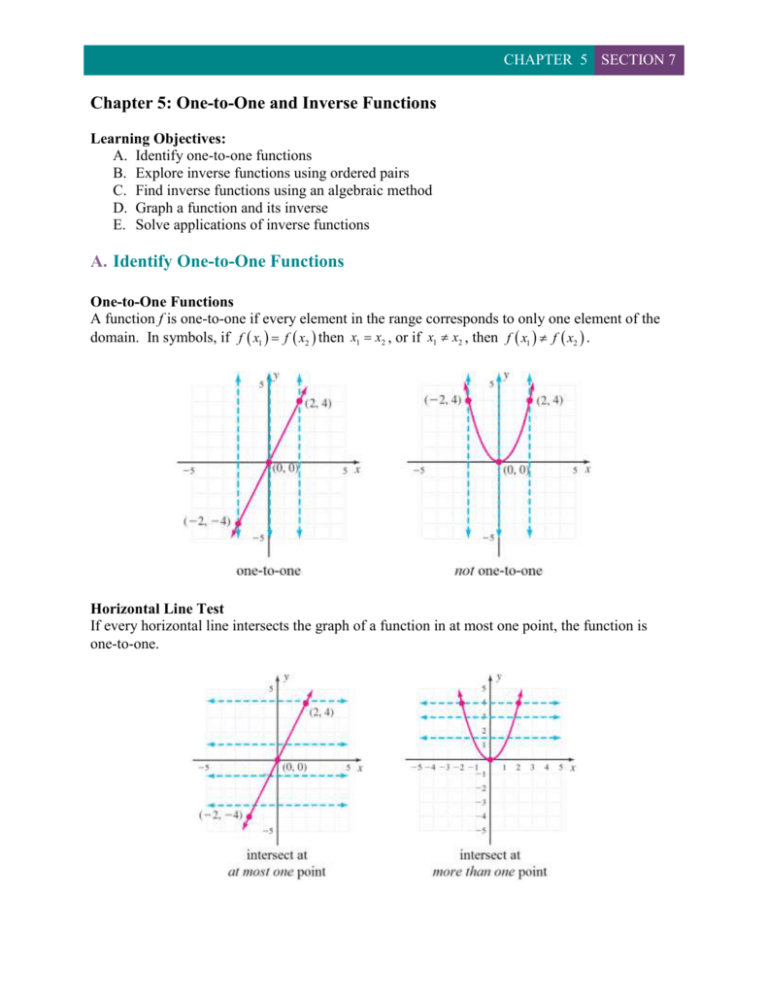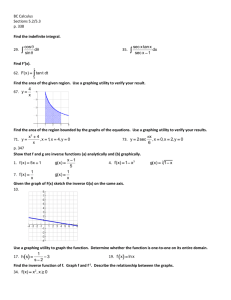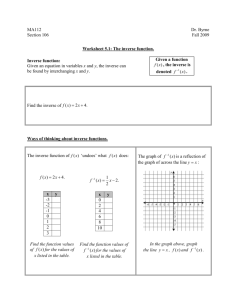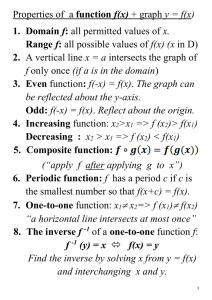Chapter 5: One-to-One and Inverse Functions
advertisement

CHAPTER 5 SECTION 7 Chapter 5: One-to-One and Inverse Functions Learning Objectives: A. Identify one-to-one functions B. Explore inverse functions using ordered pairs C. Find inverse functions using an algebraic method D. Graph a function and its inverse E. Solve applications of inverse functions A. Identify One-to-One Functions One-to-One Functions A function f is one-to-one if every element in the range corresponds to only one element of the domain. In symbols, if f x1 f x2 then x1 x2 , or if x1 x2 , then f x1 f x2 . Horizontal Line Test If every horizontal line intersects the graph of a function in at most one point, the function is one-to-one. SECTION 7 CHAPTER 5 Example: Determine whether each graph or relation shown depicts a function. If so, determine whether the function is one-to-one. a. b. c. B. Inverse Functions and Ordered Pairs Definition: An inverse function for f is one that takes the result of elements of the range, and returns the original domain element. Inverse Functions If f is a one-to-one function with ordered pairs a, b . 1. f 1 is a one-to-one function with ordered pairs b, a . 2. The range of f will be the domain of f 1 . 3. The domain of f will be the range of f 1 . Caution: The notation f 1 x is simply a way of denoting an inverse function and has nothing to do with exponential properties. In particular, f 1 x does not mean 1 . f ( x) CHAPTER 5 SECTION 7 Example: Find the inverse function of each one-to-one function given: a. 2, 7 , 1,0 , 0,1 , 1,2 , 2,9 1 b. f x x 3 4 C. Find Inverse Functions using an Algebraic Method Finding an Inverse Function 1. Replace f x with y. 2. Interchange x and y. 3. Solve the new equation for y. 4. The result gives the inverse function: substitute f 1 x for y. Example: State the domain and range of f x 1 the inverse function, and state its domain and range. 2 , then use the algebraic method to find x 3 SECTION 7 CHAPTER 5 In cases where a given function is not one-to-one, we can sometimes restrict the domain to create a function that is, and then determine the inverse. Example: Given f x x 1 , restrict the domain to create a one-to-one function, then find 4 f 1 x . State the domain and range of both resulting functions. Verifying Inverse Functions If f is a one-to-one function, then the function f 1 exists and satisfies and . Example: Use the algebraic method to find the inverse function for f ( x) Then verify the inverse you found is correct. 2x 5 . 7 CHAPTER 5 SECTION 7 D. The Graph of a Function and Its Inverse Graphing a function and its inverse on the same axes reveals the graphs are reflections across the line y = x. Example: Given the graph shown below, draw a graph of the inverse function. Functions and Inverse Functions 1. If the graph of a function passes the horizontal line test, the function is one-to-one. 2. If a function f is one-to-one, the function f 1 exists. 3. The domain of f is the range of f 1 , and the range of f is the domain of f 1 . 4. For a function f and its inverse f 1 , f o f 1 x x and f 1 o f x x . 5. The graphs of f and f 1 are symmetric about the line y = x. E. Applications of Inverse Functions Example: The volume of a can of chicken soup with a fixed height of 6 in. is given by V ( x) 6 x2 , where V(x) represents the volume in cubic inches for a can with a radius of x inches. a. Find the amount of soup in can with a radius of 2 in. that is filled to the brim. b. Find V 1 x , and discuss what the input and output variables represent.








